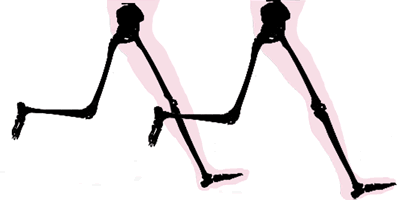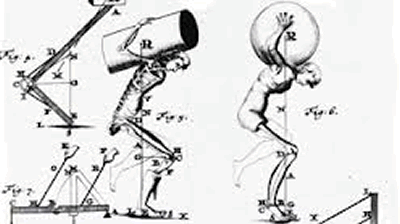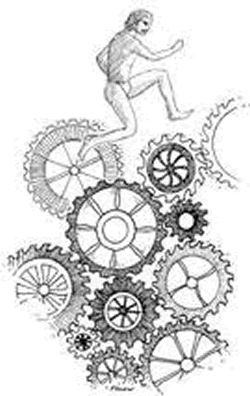Positive Health Online
Your Country

The Changing Face of Biomechanics
by Stephen Braybrook(more info)
listed in bodywork, originally published in issue 211 - January 2014
In today’s world where Biomechanical science still speaks of the laws of nature and movement within a mechanical reference and as being one that is fixed and quantified beyond future questioning, your conclusion thus would naturally think that evolution into Biomechanics has been met and no further knowledge can be or should be examined. However on inspection the foundation upon which Biomechanics has based its history may be implemented with problems and unrealities when dealing with the human organism.

This article will attempt to ask two questions: firstly is Biomechanics correct when describing all human movement? And secondly, what are the problems that have arisen if not?
Before the above two question are postulated a look at the reasons as to why Biomechanics may have problems needs addressing.
What is Biomechanics?
Biomechanics is the study of the structure and function of biological systems which is built upon the principle bathed in the mechanical philosophy of movement. This philosophy is by means of the methods of a machine; the mechanistic perspective of all living things. The next question that then needs answering is “What is a machine?” A simple machine is a non-motorized device that changes the direction or magnitude of a force. In general, a simple machine can be defined as one of the simplest mechanisms that provide mechanical advantage or leverage. It also describes how man moves based on individual isolated parts and not the integrated whole. This machine philosophy refers to the six classical simple machines which were defined by Renaissance scientists.
One of these classical machines it that of a lever and it is this lever perspective that has, does and will without challenge to its foundation continue to be imbedded with most of the Biomechanics research and teaching. This starts the problems associated with a machine law being attempted to describe the human being and will attempt to answer our first question posed in the opening passage “why is this law a problem.” Before this question is duly answered by own self-realization, a history of its origin will provide its own evidence.

The lever view of current biomechanics
Biomechanics - Historical Contributions
The scientist Giovanni Alfonso Borelli (1608-1679) contributed to various disciplines. In his On the Movement of Animals where he applied to biology the analytical and geometrical methods which were firstly developed by Galileo Galilei (1564-1642) in the field of mechanics. It is for this reason that Borelli is often called ‘the father of biomechanics’.
Borelli’s great work is almost wholly a study of animal statics in an attempt to change from visual (qualitative) observation to quantitative measurements, and was crucial for the emergence of biomechanics.
He was the first to understand and compare the human body to a machine, composed of several levers, in the firm belief that God should have created the whole world based on geometrical principles. He stated that the levers of the musculoskeletal system magnify motion rather than force, so that muscles must produce much larger forces than those resisting the motion and that bones serve as levers and muscles function according to mathematical principles; this became a basic principle for modelling human motion. This assumption came from Euclidean geometry of straight lines meeting at a defined angle and provided a postulate that the whole body in its individual parts are connected through a fixed point (the fulcrum) which provide a linear lever system.
Borelli also spoke about how movements of humans represent the real object of mathematics and should be quantified as such through different isolated parts with the main concern being the forces acting on the body, and to achieve this only static mechanics to analyze the forces at each joint could be achieved. This design of the human being could only undertake one position of freedom at a time (even in engineering mechanics there are 6 degrees of freedom being the total number available to singular equate) and established through linear actions made on a single point. Borelli also described the ends of the bones, one convex, the other concave so that contact does not occur at one point but over a wide area of many single points and where the joints are a cylindrical fulcrum over which the bone moves with the deformation being negligible and that we are made of rigid bodies.
However on inspection there appears to be problems to the above information when the human being is involved.
The main discrepancy is that if there were levers in the body the way Borelli defined, two moving bones would be touching which was outlined by the postulate involved in the lever system. If the bones are touching and for a lever to work the fulcrum must be fixed (in this case your joint), and if this were true there would be no movement at the joint and more importantly there would be no movement, period. Think about it this way: if bone A is touching bone B (fixed joint in between) touching bone C (fixed joint in between) touching bone D (so on, and so on and so on), there would only be stillness and no movement.
A large number of biologists and biomechanics teaching, studying and researching today are firmly committed to a mechanistic understanding of how living things move and exists through the commitment to attempting to understand the living with non-living elements along with the view that each individual part of the system can be mathematical equated to represent the whole, which in turn is based on estimation and guess work based on laws designed for machines. These principles are neatly encapsulated in the machine conception of the organism (MCO) which constitutes the central unifying idea of mechanistic through the explanatory and methodological reductionism approach to how biomechanics study the living systems.
For it is those who believe in the mechanistic perspective who openly suggest that all of natural which includes mankind amongst all living things and matter alike are replicated and created like complicated machines or artefacts, composed of parts which are lacking any intrinsic relationship to each other. This means that the source of the machines activities is not a whole system, but made up of individual parts who do not form a unity with another aspect of the system, with no part of the object involve directly influencing any other parts.
This provides a problem to all that study and attempt to provide evolution to the movement community as even more than 390 years of the machine views being spoken about the MCO is so engrained in the minds of working scientist that the question “What is the nature of movement and the organism?” is not even entering the educated discussions, as it is assumed that the mechanisms and mechanistic views have already answered it: the organism is a machine and moves as one.
The views that humans and all living things move and survive like a machine was first highlighted by Aristotle who compared the movements of animals to those of automatic puppets in his writing De Motu Animalium where he also likened the organs of animal motion to the parts of war machines and where he spoke about the human limb being designed like the arm of catapult. There was a very similarly description by poet Lucretius which also compared in hi works De Rerum Natura that the movements of animals to be closely related to the functioning of machines. Christian apologist Thomas Aquinas asserted in the Summa Theological that animals can be regarded as machines because they display regular and orderly behaviour. Though this information may in some views have no direct reference to 2013, what it stronger highlights is that even from these views nothing has changed if you look at how modern biomechanics speak, study and research movement.
However, it was not until Rene Descartes that the modern laws that has influenced Biomechanics and human movement were being established. For Descartes spoke and took the comparison between as he felt it was no longer simply the case that it might be helpful, under certain circumstances, to appeal to the workings of machines to illuminate the activity of human organisms, but that this view was the only way to describe and is the true nature that human organisms are machines and that this understanding of humans and all living things being a machine requires no further study.
Conflicting Theories: Machines vs Organisms
Ever since the establishment of mechanistic theory, the history of thinking about the organisms being a machine has provided a progressive theoretical and technological development of more advance machines to represent the organisms. One such advancement which provided a number to all the previous mechanistic describing the human being views was that of the seventeenth-century clock with its precise, finely-tuned parts operating as a functionally-integrated whole.

Mechanistic picture of biomechanics
At a most fundamental level, both organisms and machines can be seen as bounded physical systems that act in accordance to laws of that system. Both use or modify energy and transform part of it into work for the efficiency; the action however both are heterogeneous systems, since each part of an organism or a machine has a different structure from the whole.
As a result, they both admit relational descriptions but one as parts that make up the whole and one which is whole makes up the parts. At the same time, both organisms and machines are organized so that they operate co-ordinately towards the attainment of particular ends, and consequently both can be characterized in functional terms. Finally, the Duration of their operation is, in both cases finite so the laws of physics has attempted to provide there unity.
The problem with the theorist who sit in the mechanistic role is the failure to recognize that in any comparison between two entities, the most immediately perceptible similarities are not necessarily the most important ones. One of the most vital differences between organisms and machines is the purposive system that both organisms and machines operate towards the attainment of particular ends, with their purposiveness being that of a completely different kind. It is that this inadequacy of the mechanistic views of nature are fundamentally different from those of machines, as a machine is extrinsically purposive because it operates towards an end that is external to itself, whereby the organismic is intrinsic in its design. A machine does not serve its own interests but those of its maker or user.
In contrast, an organism is intrinsically purposive because it acts on its own behalf, towards its own ends. Its design is internal, arising from within, and serving no other purpose than to maintain its own organization. A machine is also organized, of course, given that the operation of each part is dependent on it being properly arranged with respect to every other part, and to the system as a whole. But in an organism, the parts are not just there for the sake of each other, but they also produce each other, repair each other, and generally exist by means of one another. Organisms, unlike machines, are not only organized but are also self-organizing and self-reproducing systems.
In addition Organisms have an autonomous self; the phenomena of self-formation, self-regeneration, self-preservation, and self-repair are all characteristic of the internal dynamics of living systems. Machines, on the other hand, lack an autonomous self; their means of production reside outside of themselves, demanding outside intervention not just for their construction but also for their maintenance. Indeed, for the sustained operation of a machine, an external agent is required to determine when defective components need to be repaired or replaced, and to carry them out in a timely fashion. In an organism, all of these processes are carried out from within. Therefore, confronted with a machine, one is perfectly justified in inferring the existence of an external creator responsible for producing it in accordance to a preconceived plan or design.
Dynamic complex biological systems which involve that of human movement have the tendency to spontaneously self-organize themselves to produce novel patterns. The process of self-organization is the quintessentialness of all living systems. The evolution of living beings may also be associated with the principles of self-organization through interconnected or interwoven parts which will tend to spontaneously generate new organized forms in an attempt to normalize the system. Interestingly, Darwinism essentially ignored the process of self-organization. This complexity follows the principle regarding the sum of the parts being greater than the parts taken independently. However in the classical approach outlined by Sir Isaac Newton was to approach the analysis of this complexity by mentioning there is no moderation: once a system is bounded either above or below no dynamic can be induced into the system that originates outside the bounded region. Once a set of initial conditions is specified, nothing can be changed, and the system cannot self-organize itself due to Newton’s argument that the motion of the whole is the sum of the motion of all the parts and follows directly from the classical interpretation of isolated systems.
The preceding sections have outlined the problems associating the mechanistic view to all living things, with a variety of different explanations giving as to why the machine approach may be covered with fallacies, but why is it not that this view has never been approached and challenged. One main reason is that a machines can at a rudimentary level be mathematically understood, which may give some empirical evidence to a question or series of questions posed by a Scientist. The second reason may be that to challenge an idea takes a source of courage and self-belief in what you are believing and saying.
The question then remains if the approach of the mechanistic view of living things which become the foundation for movement and biomechanics appears to be problematic as highlighted above, then the evolution of biomechanics needs to start by addressing a non-mechanistic view of all living things, including movement. This change in thought and belief would enable the evolution of Biomechanics to become fresh as it was when our forefathers first implemented the mechanistic view to all living things.
Comments:
-
Professor/Dr Brian A Rothbart said..
Excellent presentation on the possible flaws in the biomechanic model of human motion.
Personally, I believe the biomechanic is fatally flawed and have presented an alterntive model - Neurophysiological Model. I have published a paper comparing these two models (Biomechanics vs Neurophysiological) in Podiatry Review. It is available for downloading at the link below:
Rothbart BA 2011. Primus Metatarsus Supinatus (Rothbarts Foot): A common cause of musculoskeletal pain - Biomechanical vs Neurophysiological Model. Podiatry Review, Vol.68, No.4, pp 16-18 July/August.
LINK: http://rothbartsite.com/uploads/Podiatry_Review_July_2011.pdf
-
John Sharkey MSc Clinical Anatomist, Exercise physiologist said..
Nice article Stephen. For readers interested in the alternative view on both human anatomy (MyoTensegrity) and on how humans move (4 bar mechanisms) I would recommend the writings of my mentor Dr. Stephen Levin who has a wide variety of articles on this very topic. Here is a web site that will be of interest. http://www.biotensegrity.com